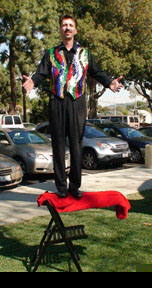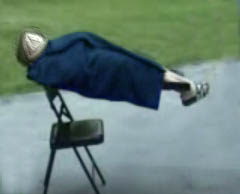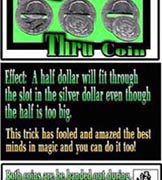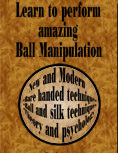Jay’s method on performing sucker tricks
We’ve all performed Sucker Sliding Die tricks where the audience yells where the die is, immediately after you open all the doors “If it’s not in the box it must be in the hat.” There’s no mystery when kids call-out the ending as you reproduce the die. You are no longer a magician and are demoted to puzzle worker.
Reverse psychology is my answer – I’ve discovered, when you make the first “Clunk” or sucker move and immediately state “The die is in the hat”….. your performance will be much stronger. The audience ignors your asertation by callin-out “It’s in the other side of the box”. As you continue to tilt the box (and sucker them) they continue insisting the die is in the other side. Each time you prepare to open the “other” door, you state “The die is not in the box but in the hat”. They will commit their position that the die is still in the box. Once they commit themselves that it’s not in the hat, you have jumped a mental hurdle. You then elevate a puzzle to a mystery when you finally produce the die from the hat. They painted themselves into a corner when they commited to the die being in the box.
When you finally open the doors on the Die Box, the audience is not eager to blurt out “It’s in the hat” because they were commited to the belief it was in the box. By causing them to verbally state the die is in the box (three times) you generate a psychilogical conflict when you prove them wrong. They can not switch their point of view easily and call out how “They knew it was in the hat the whole time” because doing so would make them admit they were wrong, and people would rather not believe they were wrong. The only explaination must be that you are a magician.
The mystery becomes that YOU did it…….. not that THEY figured out the ending, and beat you to it. There is no contest. By answering the objection before the audience raises it, the smart performer becomes the expert.
This reverse psychology also serves a few purposes for the Chair Suspension. Bt telling the kids that you don’t know if you can do the trick (just as you remove one chair) you cause them to insist the assistant IS floating…. They are so completly consumed with making you notice the floating assistant they CAN NOT find fault in the apparatus. Also, by stating that you are not floating the volunteer, the volunteer stays still because there is curosity as to how they are floating. Move it along and act like you never made the assistant float.
Try my performance strategy and let me know if it works for you.
Jay Leslie
Copyright 2005
Performing a flat-model sucker trick
A Flat-model sucker trick does not use a shell, instead it uses two duplicate objects that are flat. If the version you own allows you to retain or remove the hidden object while leaving the other one alone then read on.
For clairity lets call the double door silding box, the box and the piece where the object is removed from is not the hat but the holder.
Open Saturn holding it at the bottom (L. hand). Take the visible moon out (R. hand) and show it around, Return the moon. Don’t let go. Hold the moon with four fingers and your thumb on the back of Saturn (R. hand). Close the front (L. hand). Re-grip the far, top of Saturn (L. hand), fingers on the outside, Now… use your thumb (R. hand) to swivel the moon up from the secret holder. Remove the moon on the downbeat. I like to make a joke
“Do you know that THEY say? They say.. Behind every cloud there’s a silver lining… and do you know who THEY are? Everyone turn around, THEY are all the OLD people standing in the back!”
Needless to say. As soon as you ask them to turn around, pull the duplicate moon from the back of Saturn. Then the fun begins, Set Saturn aside and go into the sucker part of the routine.
Place the moon in the double door cloud box. Right now I’m going to make the moon disappear from behind the clouds and magically go back to Saturn, like magic. (Close the door and tilt the box so a “clunk” is heard. Open the same door) The moon is gone. (Kids usually insist you open the other door. If not, look at one of them and say) “Oh you want me to open the other door?” (Tilt the cloud box opening the wrong door opposite the moon on each tilt. Insist that the moon is already behind Saturn. Ask the kids if they want you to open both doors. Lay the cloud box almost flat on your bent knee or table, hiding the hole, and open both doors but tilting it so no one can see inside). Yep… They’re open… and I don’t see the moon (close both doors). OoooH, you want to SEE BOTH doors open? (Turn the cloud box so the back faces the audience, hiding the hole, and open both doors all the way, (move your thumb out of the way as the door swings open). There you are… Both doors are open! OooH, you want me to turn it around? (Hold the cloud box close against your coat and do a 360 revolution ending up in the same position). OooH, you want me to turn the box around? But kids, the moon has vanished. It’s already back in the other box. No??? OK, I’ll turn it around. (Hiding the hole, turn the cloud box around like hand-over-hand steering with you steering wheel. Close the doors and turn them to the audience tilting it so the moon drops behind the fake). People!!! The moon is really at saturn..
REVEAL (Hold the moon in place with your thumb through the hole. Hold the sides of the Cloud Box with both hands. Thrust your arms forward and stop sharply so both doors open. Allow the audience to see inside, for two seconds – back lit 4 seconds – close the doors)

 The one thing I can’t stand is when a chair suspension sags. This one does not.
The one thing I can’t stand is when a chair suspension sags. This one does not. Not only do the majority of suspension sag like this but you have to lift the legs of the volunteer like you are jacking up a car.
Not only do the majority of suspension sag like this but you have to lift the legs of the volunteer like you are jacking up a car.

